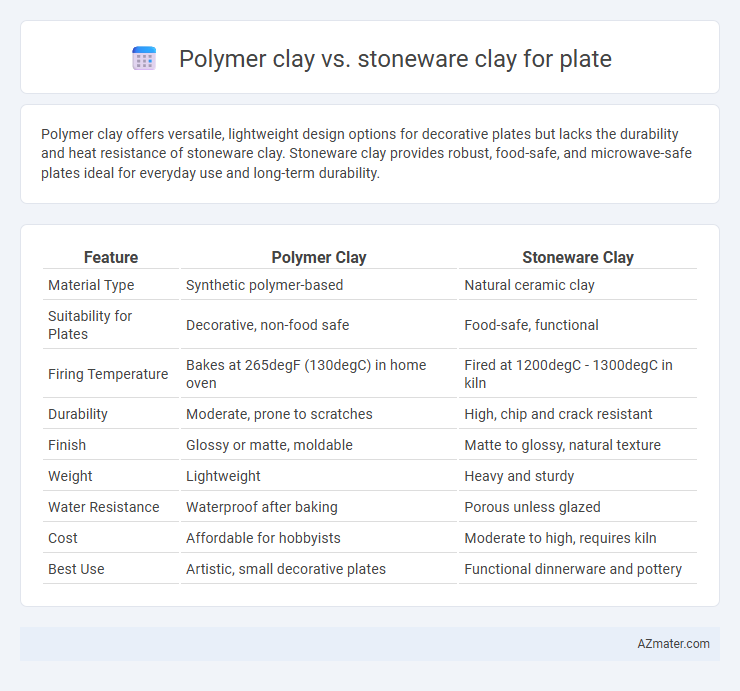Polymer clay offers versatile, lightweight design options for decorative plates but lacks the durability and heat resistance of stoneware clay. Stoneware clay provides robust, food-safe, and microwave-safe plates ideal for everyday use and long-term durability.
Table of Comparison
| Feature | Polymer Clay | Stoneware Clay |
|---|---|---|
| Material Type | Synthetic polymer-based | Natural ceramic clay |
| Suitability for Plates | Decorative, non-food safe | Food-safe, functional |
| Firing Temperature | Bakes at 265degF (130degC) in home oven | Fired at 1200degC - 1300degC in kiln |
| Durability | Moderate, prone to scratches | High, chip and crack resistant |
| Finish | Glossy or matte, moldable | Matte to glossy, natural texture |
| Weight | Lightweight | Heavy and sturdy |
| Water Resistance | Waterproof after baking | Porous unless glazed |
| Cost | Affordable for hobbyists | Moderate to high, requires kiln |
| Best Use | Artistic, small decorative plates | Functional dinnerware and pottery |
Introduction to Polymer Clay and Stoneware Clay
Polymer clay is a versatile, synthetic modeling material composed primarily of polyvinyl chloride (PVC) combined with a plasticizer, offering vibrant colors and easy sculptability for intricate plate designs. Stoneware clay, a natural ceramic material composed of refined clay and minerals, requires high-temperature firing to achieve a durable, dense, and vitrified finish, ideal for functional plates with robust strength and chip resistance. Both clays serve distinct purposes, with polymer clay excelling in decorative and lightweight applications, while stoneware clay is preferred for durable, everyday-use dinnerware.
Composition and Properties of Polymer Clay
Polymer clay is a synthetic modeling material composed primarily of polyvinyl chloride (PVC) resin mixed with plasticizers, allowing it to remain pliable until cured by heat. It offers excellent flexibility, lightweight durability, and a smooth finish, making it ideal for intricate plate designs that do not require the heat resistance or structural strength of stoneware clay. Unlike stoneware, which is made from natural clay fired at high temperatures to achieve hardness and porosity reduction, polymer clay hardens at low temperatures and is waterproof but less suitable for functional dinnerware exposed to heat.
Characteristics of Stoneware Clay
Stoneware clay is a highly durable, dense, and non-porous material fired at high temperatures typically between 1200degC and 1300degC, making it ideal for functional plates resistant to chipping and thermal shock. Its natural stone-like texture provides a robust surface that withstands everyday use, including dishwasher and microwave safety, unlike polymer clay which is a synthetic, lower-temperature cured material. Stoneware's capacity to retain glaze and develop unique, earthy finishes enhances both the aesthetic and practical value of ceramic plates.
Workability: Molding and Shaping Differences
Polymer clay offers superior workability with its lightweight, pliable texture, allowing intricate molding and shaping without cracking or drying out. Stoneware clay requires careful moisture control and patience due to its heavier, denser consistency, which can make detailed shaping more challenging but provides a sturdy structure once fired. The difference in flexibility during the sculpting process directly impacts the ease of creating fine details and the overall handling experience.
Durability and Strength Comparison
Polymer clay is a lightweight, flexible material that lacks the high durability and strength of stoneware clay, making it more prone to cracking and deformation under heavy use. Stoneware clay, fired at high temperatures (typically between 1200degC and 1300degC), achieves a dense, vitrified structure that provides superior mechanical strength and resistance to thermal shock. Plates made from stoneware clay are significantly more durable, chip-resistant, and suitable for everyday functional use compared to the more fragile and less heat-resistant polymer clay plates.
Baking and Firing Requirements
Polymer clay requires baking at a low temperature around 265degF to 275degF (130degC to 135degC) for 15 to 30 minutes per 1/4 inch thickness, allowing it to harden without cracking. Stoneware clay demands high-temperature firing in a kiln, typically between 2192degF and 2345degF (1200degC to 1285degC), which vitrifies the clay and makes it durable and food-safe. The significant difference in baking and firing temperatures affects the final plate's strength, heat resistance, and suitability for daily use.
Food Safety: Which Clay is Safer for Plates?
Polymer clay is not food-safe for plates as it can leach harmful chemicals when in contact with food, while stoneware clay fired at high temperatures becomes non-porous and safe for direct food contact. Stoneware plates are typically glazed with food-safe materials that comply with FDA regulations, ensuring no toxins contaminate the food. For durable, heat-resistant, and safe dinnerware, stoneware clay is the superior choice compared to polymer clay.
Aesthetic Possibilities: Colors and Finishes
Polymer clay offers vibrant color options with a smooth, consistent finish, allowing for intricate designs and a glossy or matte surface that mimics porcelain or enamel. Stoneware clay provides earthy, natural tones ranging from warm browns to slate greys, enhanced by various glazing techniques that create textured, rustic, or glossy finishes. The choice between polymer and stoneware clay depends on whether bold, customizable colors or classic, organic aesthetics are preferred for plate creation.
Cost and Accessibility for Crafters
Polymer clay offers greater affordability and widespread availability, making it a popular choice for crafters producing decorative plates. Stoneware clay typically involves higher costs due to its natural materials and kiln-firing process, limiting accessibility for hobbyists without specialized equipment. Budget-conscious crafters favor polymer clay for its cost-efficient, easy-to-purchase supplies and no requirement for professional firing.
Best Choice: Which Clay is Ideal for Plates?
Stoneware clay is ideal for plates due to its durability, heat resistance, and food-safe properties, making it suitable for everyday use and dishwasher safety. Polymer clay, while versatile for decorative purposes, lacks the robustness and heat tolerance required for functional dinnerware. For durable, practical plates, stoneware ensures long-lasting performance and safety.

Infographic: Polymer clay vs Stoneware clay for Plate
 azmater.com
azmater.com